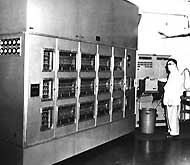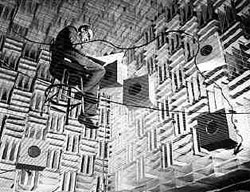|
|
|
|
 |
|
|
|
| |
 14 14

 The first analogue
synthesizers and computers: composing one's own sound
The first analogue
synthesizers and computers: composing one's own sound
The tape recorder gives musicians
the ability to record sounds and use them as they wish.
Computers and analogue synthesizers brought with them
a new kind of musical revolution for composers and musiciens:
the ability to compose thier own sonic material. in 1942,
John Cage wrote : 'Many musicians dream of compact
technological boxes out of which would come any audible
sound they fancy'.
• Computer Music (1)
 Around
1956, Lejaren A. Hiller and Leonard M. Isaacson
presented the first music composed with the help of a
computer: Illac Suite for string quartet, realized at
the studio of the Universtity of Illinois's Computer Research
Center. These first substantial attempts at computer-automated
composition are done of the Illiac I computer (IBM 7094). Around
1956, Lejaren A. Hiller and Leonard M. Isaacson
presented the first music composed with the help of a
computer: Illac Suite for string quartet, realized at
the studio of the Universtity of Illinois's Computer Research
Center. These first substantial attempts at computer-automated
composition are done of the Illiac I computer (IBM 7094).
But, the development of computer-assisted music also had
another motivation: sound production. In that field, the
pioneer in computer sound synthesis (or digital synthesis)
is the musician and electronic engineer Max V. Mathews.
The first computer-generated sound was heard in 1957,
in Bell AT&T's Acoustics & Psychology Labs at
Murray Hill (New Jersey), thanks to the sound generation
software Music I, which ran on an IBM 7040. This
mutation was made possible with the help of Henk McDonald,
John R. Pierce aud Newman Guttman. On May 17,
1957 Guttman, a psychologist, premiered in The Silver
Scale, the very first computer music work, 15 seconds
long. Three years later, the first record of computer-generated
was released: Music from Mathematics, by J.R. Pierce
and Max Mathews. This record contained, among other works,
the first computer song: Bicycle Built for Two,
which became famous in Stanley Kubrick's classic
film 2001: A Space Odyssey, as the computer Hal 9000's
swan song. Afterwards, several composers worked with these
first pieces of software, including John Cage, Iannis
Xenakis, John Chowning and Morton Subotnick.
 In
1968, Bell Telephone laboratories released Music V
(Mathews, Moore, Risset, Miller), a synthesis software
written in Fortran (FORmula TRANslator) and organized
into a modular structure of sound generators. Music V
can still be found at the core of several sound synthesis
programs. The Groove (Generated Real-time Output
Operations on Voltage-controlled Equipement) System developed
in 1967 by Max Mathews and Richard Moore was the
first real-time computer-automated composition system.
It was extensively used by Laurie Spiegel in Appalachian
Grove (1974) and Emmanuel Ghent in Phosphones
(1971), and later by Pierre Boulez and Gerard Schwartz.. In
1968, Bell Telephone laboratories released Music V
(Mathews, Moore, Risset, Miller), a synthesis software
written in Fortran (FORmula TRANslator) and organized
into a modular structure of sound generators. Music V
can still be found at the core of several sound synthesis
programs. The Groove (Generated Real-time Output
Operations on Voltage-controlled Equipement) System developed
in 1967 by Max Mathews and Richard Moore was the
first real-time computer-automated composition system.
It was extensively used by Laurie Spiegel in Appalachian
Grove (1974) and Emmanuel Ghent in Phosphones
(1971), and later by Pierre Boulez and Gerard Schwartz..
 Ever
since they started working at Bell Laboratories, John
Pierce and Max Mathews were eager to work
with musicians. The thinker and composer James Tenney
(b. 1934) created several music pieces from 1961 to 1964,
thus taking part to the development of several music composition
programs. His first piece, the 1961 Analog #1(Noise
Study), was inspired by the aleatory noises heard in Route
22 and in the Holland Tunnel between Manhattan ant New
Jersey. For Dialogues (1963), Tenney used various
stochastic techniques to determine how to organize the
sounds. Differents types of sounds are statistically combined,
their textures changing constantly, as if the works consisted
of numerous sounds in a wide range of shapes ans colours.
In 1963, Mathews published a paper on computer music:
'The Digital Computers as a Musical Instrument'.
It influenced a whole generation of musicians. Ever
since they started working at Bell Laboratories, John
Pierce and Max Mathews were eager to work
with musicians. The thinker and composer James Tenney
(b. 1934) created several music pieces from 1961 to 1964,
thus taking part to the development of several music composition
programs. His first piece, the 1961 Analog #1(Noise
Study), was inspired by the aleatory noises heard in Route
22 and in the Holland Tunnel between Manhattan ant New
Jersey. For Dialogues (1963), Tenney used various
stochastic techniques to determine how to organize the
sounds. Differents types of sounds are statistically combined,
their textures changing constantly, as if the works consisted
of numerous sounds in a wide range of shapes ans colours.
In 1963, Mathews published a paper on computer music:
'The Digital Computers as a Musical Instrument'.
It influenced a whole generation of musicians.
Jean-claude Risset was a Physics student in France,
at the time. He decided to write his thesis on Mas Mathews's
research. He went to the Bell Laboratories in 1964 to
start working on timbre, and wrote Little Boy (1966)
and Mutations I (1969). Risset's 'sound' is characterized
by the physical illusion it generates - a feeling of going
up or down! The IRCAM opened in Paris in 1974 and Risset
was appointed head of the Computer Music Department. The
IRCAM (Institut de Recherche et Coord ination
Acoustique Musique) is a research centre for composers,
where sound synthesis, spatialization and notation programs
are developed. This centre still exists; it also offers
courses in sound perception and acoustics.. ination
Acoustique Musique) is a research centre for composers,
where sound synthesis, spatialization and notation programs
are developed. This centre still exists; it also offers
courses in sound perception and acoustics..
John
Chowning also decided to study computer science after
reading Mas Mathews' paper. In 1967, he invented FM
(frequency modulation) - based sound synthesis, a
new sound generation technique allowing timbral transformations.
Later with David Poole, he put together in Stanford
a laboratory that would became the CCRMA (Center
for Computer Research in Music and Acoustics) in 1975.
His approach and his discovery of FM synthesis served
as the basis in the development of most of Yamaha's synthesizers
in the 80's, including the famous DX7. Chowning's first
compositions were Sabelithe (1971) and Turenas
(1972), both offering the feeling of sound moving through
space, and Stria (1977), a solo tape composition.
These pieces sound utterly strange, ice-cold and eons
away from any sound an acoustic instrument could produce.
In the 60's Max V. Mathews, James Tenney, Jean-claude
Risset and John Chowning were among the first
composers to use computers. They were joined over the
next two decades by Charles Dodge, Hubert Howe, Jim
Randall, Geoffrey Winham, Paul Lansky, Jonathan Harvey,
Trevor Wishart, Barry Vercoe, Larry Austin, François
Bayle, Dexter Morrill, James Dashow, Iannis Xenakis, William
Albright, Bill Schottstaedt, Dennis Smalley and many
more. These pioneers had to work harderback then the musicians
of today; a perfect understanding of computer systems
and programming was essential. It could take days between
composing new material and being able to listen to the
results. Nowadays, the effect follows the cause almost
instantaneously. In the early times of digital synthesis,
Mathews explained: 'It takes twenty minutes of computer
time for each second sound. It was to be a remarkable
second to make the effort wortwile'.


|

 |
|


|
|
|
 s u g g e s t i o n s
s u g g e s t i o n s
f o r l i s t e n i n g
|
|
> Lejaren Hiller
Illiac suite for string quartet, 1956
Computer Cantata, 1963
Electronic Sonata, 1976
> Max Mathews
Numerology,
1960
Bicycle Built for Two,
1961
The Second Law, 1961
Masquerades, 1963
International Lullaby, 1966
> John R. Pierce
Stochata, 1959
Variations In Timbre And Attack, 1961
Sea Sounds, 1963
Eight-Tone Canon, 1966
> Newman Guttman
The Silver Scale, 1957
Pitch Variations, 1957
>
James Tenney
Noise study, 1961
Four Stochastic Studies, 1962
Dialogue, 1963
Phases, 1963
Stochastic string Quartet, 1963
> Ercolino Ferretti
Pipe and Drum, 1963
Trio, 1965
> Jim Randall
Quartets in Pairs, 1964
Mudgett, 1965
Mudgett: Monologues for a Mass Murderer, 1965
Lyric Variations, 1966
>Emmanuel Ghent
Helices, 1969
Phosphones, 1971
Brazen, 1975
> David Lewin
Study N° 1, 1961
Study N° 2, 1961
>
Laurie Spiegel
Sediment,
1972
Appalachian Grove, 1974
Clockworks, 1975
A Voyage, 1976
> Herbert Brün
Non Sequitur VI, 1966
Indefraudibles, 1968
> Jean claude Risset
Computer suite for little boy, 1968
Mutations I, 1969
Inharmonique, 1977
Songes, 1979
> Charles Dodge
Changes, 1969
Earth's magnetic field, 1970
He Destroyed Her Image,
1972
Speech Songs, 1972
In celebration, 1975
>John Chowning
Sabelith, 1966-71
Turenas, 1972
Stria, 1977
Phone, 1981
> Jonathan Harvey
Mortuos plangos vivos voco, 1980
> Jean-Baptiste Barriere
Chréode 1, 1983
> Pierre Boulez
Dialogue de l'ombre ouble, 1985
>
Philippe Manoury
La partition du ciel et de l'enfer, 1989
> Paul Lansky
Idle Chatter, 1984
> Trevor Wishart
Vox 5, 198
> James Dashow
Whispers out of Time, 1976
> Iannis Xenakis
Mycenae-Alpha, 1978
>
William Albright
Sphaera, 1985
> Bill Schottstaedt
Dinosaur Music, 1986
> Kaija Saariaho
Noanoa, 1991
> Dennis Smalley
Gradual, 1974
> David Rosenboom
Zones Of Influence, 1985
|
|
|
|